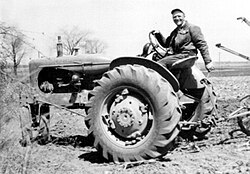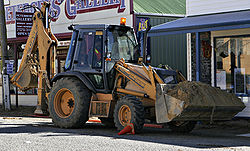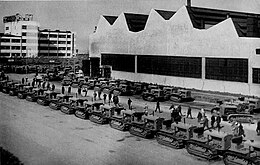Tractor

A tractor (from Latin trahere "to pull"; a conflicting history of the name is that steam tractors were originally referred to as traction engines, eventually becoming a contraction of 'traction' and 'motor') is a device intended for drawing, towing or pulling something which cannot propel itself and, often, powering it too. Most commonly the word is used to describe a vehicle intended for such a task on some other vehicle or object.
In Britain and India the word "tractor" usually means "farm tractor", and using "tractor" to mean other types of vehicles is known of in the vehicle trade but unfamiliar to much of the general public.
Farm tractor
The most common use of the term tractor is for the vehicles used on farms. The farm tractor is used for pulling or pushing agricultural machinery or trailers, for plowing, tilling, disking, harrowing, planting, and similar tasks.
The first mechanized farm implements in the 1800's and early 1900's were steam tractors. These were built around steam engines, which were not very safe and could explode or entangle their operators in the belt driven attachments. In 1892, John Froelich built the first practical gasoline powered tractor in Clayton County, Iowa. While unpopular at first, these gasoline powered machines began to catch on in the 1910s as large companies such as Ford and John Deere began manufacturing them. By the 1920s, tractors with a gasoline powered internal combustion engine had become the norm.
The classic farm tractor is a simple open vehicle with two very large driving wheels on an axle below and slightly behind a single seat (the seat and steering wheel consequently are in the center) and the engine in front of the driver with two steerable wheels below the engine compartment. This basic design has remained unchanged for a number of years, but enclosed cabs are fitted on almost all modern models, for reasons of operator safety and comfort.
There are also lawn tractors. John Deere, Cub Cadet, Toro and Husqvarna are some of the better known brands. Vist their respective websites or visit for more info
Operation
On modern farm tractors there are usually four foot-pedals, for the operator, on the floor of a tractor. The pedal on the left is the clutch. The operator presses on this pedal to disengage the transmission for either shifting gears or stopping the tractor. Two of the pedals on the right are the brakes. The left brake pedal stops the left rear wheel and the right brake pedal does the same with the right side. This independent left and right wheel braking augments the steering of the tractor when only the two rear wheels are driven. This is usually done when it is necessary to make a tight turn. The split brake pedal is also used in mud or soft dirt to control a tire that spins due to loss of traction. The operator presses both pedals together to stop the tractor. For tractors with additional front-wheel drive this operation often engages the 4-wheel locking differential to help stop the tractor when travelling at road speeds.
The pedal furthest to the right is the foot throttle. Unlike in automobiles, it can also be controlled from a hand-operated lever ("hand throttle"). This helps provide a constant speed in field work. It also helps provide continuous power for stationary tractors that are operating an implement by shaft or belt. The foot throttle gives the operator more automobile-like control over the speed of the tractor for road work. This is a feature of more recent tractors, older tractors often did not have this feature. When travelling on the road in the UK it is mandatory to use the foot pedal to control engine speed.
Power and transmission
Modern farm tractors employ large diesel engines, which range in power output from 18 to 500 horsepower (15 to 400 kW). Tractors can be generally classified as two-wheel drive, two-wheel drive with front wheel assist, or four-wheel drive (often with articulated steering). Variations of the classic style include the diminutive lawn tractors and their more capable and ruggedly constructed cousins, garden tractors, that range from about 10 to 25 horsepower and are used for smaller farm tasks and mowing grass and landscaping. Their size—especially with modern tractors—and the slower speeds are reasons motorists are urged to use caution when encountering a tractor on the roads.
Most tractors have a means to transfer power to another machine such as a baler, slasher or mower. Early tractors used belts wrapped around pulleys to power stationary equipment. Modern tractors use a power take-off shaft (PTO) to provide rotary power to machinery that may be stationary or pulled. Almost all modern tractors can also provide external hydraulic and electrical power.
Most farm tractors use a manual transmission. They have several gear ratios that, generally, provide a range of speeds from less than one mile per hour up to about 25 miles per hour. Older tractors usually require that the operator depress the clutch in order to shift between gears (a limitation of straight-cut gears in the gearbox), but many modern tractors have eliminated this requirement with the introduction of technologies such as continuously variable transmission. This allows the operator more and easier control over working speed than the throttle alone could provide.
Slower speeds are necessary for most operations that are performed with a tractor. They help give the farmer a larger degree of control in certain situations, such as field work. However, when travelling on public roads, the slow operating speeds can cause problems, such as long queues or tailbacks, which can delay or aggrevate other road users. To alleviate conditions, some countries (for example the Netherlands) employ a road sign on some roads that means "no farm tractors". Some modern tractors, such as the JCB Fastrac, are now capable of much more tolerable road speeds of around 50 mph.
Safety
Modern tractors have rollover protection systems (ROPS) to prevent an operator from being crushed if the tractor rolls over. This is especially important in open-air tractors where the ROPS is a steel beam that extends above the operator's seat. For tractors with operator cabs, the ROPS is part of the frame of the cab. Before ROPS were required many farmers died when their tractors rolled on top of them. Row-crop tractors, before ROPS, were particularly dangerous because of their 'tricycle' design with the two front wheels spaced close together and angled inward toward the ground. Many farmers were killed by rollovers while operating tractors along steep slopes. ROPS were first required by legislation in New Zealand in the 1960s.
Applications
Farm implements can be attached to the rear of the tractor by either a drawbar or by a three-point hitch. The three-point hitch was invented by Harry Ferguson and has been a standard since the 1960s. Equipment attached to the three-point hitch can be raised or lowered hydraulically with a control lever. The equipment attached to the three-point hitch is usually completely supported by the tractor. Another way to attach an implement is via a Quick Hitch, which is attached to the three-point hitch. This enables a single person to attach an implement quicker and put the person in less danger when attaching the implement.
Some farm-type tractors are found elsewhere than on farms: with large universities' gardening departments, in public parks or for highway workman use with blowtorch cylinders strapped to its sides and a pneumatic drill air compressor permanently fastened over its power take-off.
Precision agriculture
Space technology has found its way into down to agriculture in the form of GPS devices, and robust on-board computers installed as optional features on farm tractors. These technologies are used in modern, precision farming techniques. The spin-offs from the space race have actually facilitated automation in plowing and the use of driverless drone tractors that work in tandem with manned tractors on large corporate-scale farms.
Current manufacturers
- AGCO Corporation
- Big Bud
- CNH Global
- Deere & Company
- McCormick Tractors International
- Steiger Tractor Company
- Versatile
Backhoe loader
The most common variation of the classic farm tractor is the loader-backhoe, also called a backhoe-loader. As the name implies, it has a loader assembly on the front and a backhoe on the back. When both the loader and the backhoe are permanently attached it is almost never called a tractor, not generally used for towing and usually does not have a power take-off. When the backhoe is permanently attached, the machine usually has a seat that can swivel to the rear to face the hoe controls. Removable backhoe attachments almost always have a separate seat on the attachment.
Backhoe-loaders are very common and can be used for a wide variety of tasks: construction, small demolitions, light transportation of building materials, powering building equipment, digging holes, breaking asphalt and paving roads. Some buckets have a retractable bottom, enabling them to empty their load more quickly and efficiently. Buckets with retractable bottoms are also often used for grading and scratching off sand. The front assembly may be a removable attachment or permanently mounted. Often the bucket can be replaced with other devices or tools.
Their relatively small frame and precise control make backhoe-loaders very useful and common in urban engineering projects such as construction and repairs in areas too small for larger equipment. Their versatility and compact size makes them one of the most popular urban construction vehicles.
Engineering tractors
The durability and engine power of tractors made them very suitable for engineering tasks. Tractors can be fitted with engineering tools such as dozer blade, bucket, hoe, ripper, and so on. The most common attachments for the front of a tractor are dozer blade or a bucket. When attached with engineering tools the tractor is called an engineering vehicle.
A bulldozer is a tracked-type tractor attached with blade in the front and a rope-winch behind. Bulldozers are very powerful tractors and have excellent ground-hold, as their main tasks are to push or drag things.
Bulldozers have been further modified over time to evolve into new machines which are capable of working in ways that the original bulldozer can not. One example is that loader tractors were created by removing the blade and substituting a large volume bucket and hydraulic arms which can raise and lower the bucket, thus making it useful for scooping up earth, rock and similar loose material to load it into trucks.
A front-loader or loader is a tractor with an engineering tool which consists of two hydraulic powered arms on either side of the front engine compartment and a tilting implement. This is usually a wide open box called a bucket but other common attachments are a pallet fork and a bale grappler.
Other modifications to the original bulldozer include making the machine smaller to let it operate in small work areas where movement is limited. There are also tiny wheeled loaders, officially called Skid-steer loaders but nicknamed "Bobcat" after the original manufacturer, which are particularly suited for small excavation projects in confined areas.
EPA tractor

During World War 2 there was a shortage of tractors in Sweden and this lead to the invention of a new type of tractor called the EPA tractor (EPA was a chain of discount stores and it was often used to signify something of lacking in quality). An EPA tractor was simply an automobile, truck or lorry, with the passenger space was cut off behind the front seats, equipped with two gearboxes in a row. When done to an older car with a ladder frame, the result was not dissimilar to a tractor and could be used as one.
After the war it remained popular, now not as a farm vehicle, but as a way for young people without a driver's license to own something similar to a car. Since it was legally seen as a tractor it could be driven from 16 years of age and only required a tractor license. Eventually the legal loophole was closed and no new EPA tractors were allowed to be made, but the remaining were still legal, something that led to inflated prices and many protests who people that preferred EPA tractors to ordinary cars.
In March 31, 1975 a similar type of vehicle was introduced, the A tractor [from arbetstraktor (work tractor)]. The main difference is that an A tractor has a top speed of 30 km/h. This is usually done by fitting two gearboxes in a row and not using one of them. Volvo Duett was for a long time the primary choice for conversion to an EPA or A tractor, but since supply have since dried up other cars have been used, in most cases a Volvo.
Other types of tractors
The term tractor or tractor unit (UK) is also applied to:
- Road tractors or tractor trucks
- Heavy-duty vehicles with large engines and several axles. These tractors are designed to pull long road trailers, most often for the transport of freight of some kind over a significant distance (see semi-trailer). In England this type of "tractor" is often called an "artic cab".
- Locomotive tractors (engines)
- the amalgamation of machines, generators, controls and devices that comprise the traction component of railway vehicles
- Artillery tractors
- Vehicles used to tow artillery pieces of varying weights.
- UP Diesel.jpg
Diesel locomotive at work
- Komsom 05.jpg
Komsomolets Soviet artillery tractor
In aerospace
In aircraft, a tractor configuration refers to the propellers being in front of the fuselage or wing. Conversely, if to the rear, it is a called a pusher configuration.
NASA and other space agencies use very large tractors to ferry launch vehicles like booster rockets and space shuttles from their hangars to (and in rare cases, from) the launchpad.
In computers
A tractor is also the part of a computer printer that pulls paper into the device or pushes it along. This usually takes the form of a toothed gear that meshes with holes punched near the edge of the paper, or a belt or wheel with rubber or other high-friction surface that makes contact with the paper.
See also
- Tractor beam
- List of farm implements
- Backhoe loader
- Bulldozer
- Crane
- Engineering vehicles
- Excavator
- Grader
- Front loader
- Skid loader
- Space technology
- Tractor pulling






